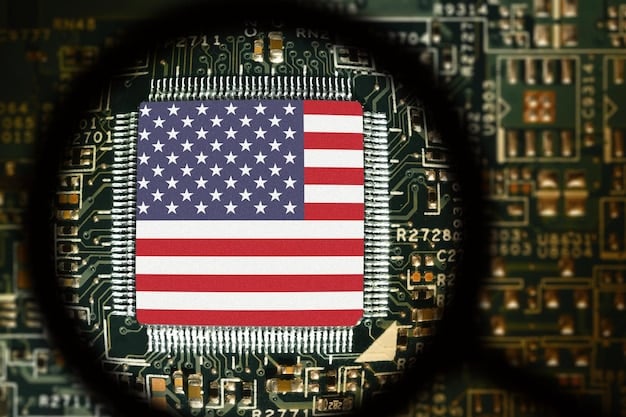US Cyber Warfare Policy: Analyzing Impact & Latest Changes

The US response to cyber warfare involves a multi-faceted approach encompassing policy changes, technological advancements, and international collaborations to defend against and deter cyber threats, aiming to protect critical infrastructure and national security interests.
In an increasingly interconnected world, the threat of cyber warfare looms large. The US response to cyber warfare: Analyzing the latest policy changes and their global impact is a critical area of study, demanding our attention as we navigate the complexities of digital-age conflict.
Understanding the Evolving Landscape of Cyber Warfare in the US
Cyber warfare is no longer a futuristic concept; it is a present-day reality. The US has been at the forefront of both experiencing and responding to cyber threats, leading to significant policy changes and strategic adaptations. Understanding this evolution is crucial to grasp the current state of affairs.
From initial responses focused on securing government networks to a more comprehensive approach involving public-private partnerships and international cooperation, the US strategy has transformed to address the increasingly sophisticated nature of cyber attacks. This evolution reflects a growing awareness of the potential damage cyber warfare can inflict on national security and economic stability.
Key Historical Cyber Incidents Affecting the US
Several high-profile cyber incidents have shaped the US response to cyber warfare. These incidents have served as wake-up calls, prompting increased investment in cybersecurity, the development of new policies, and a greater emphasis on threat intelligence.
- Titan Rain: A series of coordinated attacks targeting US defense contractors in the early 2000s, attributed to Chinese hackers, highlighted vulnerabilities in supply chain security.
- Operation Buckshot Yankee: The 2008 intrusion into US Central Command’s networks revealed the potential for adversaries to gain access to sensitive military information.
- Shamoon Virus: This destructive malware attack in 2012 targeted Saudi Aramco and demonstrated the capacity of cyberattacks to disrupt critical infrastructure.
- WannaCry Ransomware Attack: The 2017 global ransomware attack impacted numerous organizations, including hospitals and businesses in the US, underscoring the widespread vulnerability to cyber threats.

These incidents and others have highlighted the need for a proactive and adaptive approach to cybersecurity. The US has responded by developing new strategies, investing in technology, and fostering collaboration between different sectors.
Analyzing Key US Policy Changes in Cyber Warfare
In response to the dynamic nature of cyber threats, the US has implemented several key policy changes. These changes reflect a deeper understanding of cyber warfare, encompassing both defensive and offensive capabilities.
These policy changes aim to create a more resilient and secure cyberspace while also deterring potential adversaries from engaging in malicious cyber activities. The policies address various aspects of cyber warfare, from intelligence gathering to incident response and international cooperation.
Shift Towards Active Cyber Defense
One significant shift is the move towards active cyber defense. This involves not only defending US networks but also proactively identifying and neutralizing threats before they can cause harm. Active cyber defense includes techniques like threat hunting and intrusion detection, aimed at identifying and mitigating vulnerabilities before they are exploited.
- Cyber Command’s Role Expansion: The US Cyber Command has seen its role expand significantly from defensive operations to include offensive capabilities, allowing for a more robust response to cyber threats.
- Deterrence Strategies: Development of strategies to deter adversaries through a combination of defensive readiness, offensive capabilities, and clear articulation of consequences for malicious cyber activities.
- Public-Private Partnerships: Encouraging collaboration between government agencies and private sector companies to share threat intelligence and best practices in cybersecurity.
This proactive approach recognizes the need to stay ahead of evolving cyber threats and to deter potential adversaries through a strong and capable cyber defense posture.
The Role of US Cyber Command in Modern Warfare
The US Cyber Command (USCYBERCOM) plays a pivotal role in the nation’s cyber warfare strategy. Established in 2010, USCYBERCOM is responsible for defending US military networks and conducting offensive cyber operations when authorized.
As cyber warfare becomes an integral part of modern warfare, USCYBERCOM’s responsibilities and capabilities have grown significantly. The command works closely with other government agencies, including the Department of Homeland Security and the intelligence community, to coordinate cyber defense efforts.

USCYBERCOM’s Offensive and Defensive Capabilities
USCYBERCOM possesses a range of capabilities, both offensive and defensive, that are crucial to its mission. These capabilities include the ability to conduct network surveillance, identify vulnerabilities, and deploy countermeasures to protect US networks.
The offensive capabilities of USCYBERCOM are designed to deter adversaries and, if necessary, to disrupt or degrade their cyber capabilities. These capabilities are subject to strict legal and policy controls to ensure that they are used responsibly and in accordance with international law.
- Network Security Operations: Defending US military networks from cyber attacks by implementing security measures, monitoring network traffic, and responding to incidents.
- Intelligence Gathering: Collecting and analyzing intelligence about cyber threats and adversaries to inform decision-making and improve defenses.
- Cyber Warfare Exercises: Conducting exercises and simulations to test and improve the readiness of US forces to respond to cyber attacks.
USCYBERCOM’s role continues to evolve as cyber warfare becomes more sophisticated and prevalent. The command is at the forefront of efforts to defend US interests in cyberspace and deter potential adversaries.
Global Impact of US Cyber Warfare Policies
The US cyber warfare policies have a significant global impact, influencing norms, practices, and international relations in cyberspace. The US approach to cyber warfare has set a standard for other nations and has shaped the debate on the use of force in cyberspace.
As a major player in cyberspace, the US has a responsibility to promote stability and security. Its policies and actions have far-reaching consequences, affecting everything from international law to the development of new technologies designed to counter cyber threats.
International Cooperation and Alliances
The US has actively sought to foster international cooperation on cybersecurity issues. This includes working with allies to share threat intelligence, develop common standards, and conduct joint exercises. These partnerships are essential to addressing the global nature of cyber threats.
- NATO Cyber Defense Pledge: The US has been a strong proponent of strengthening cyber defense capabilities within NATO, including a pledge by member states to assist each other in the event of a cyber attack.
- Bilateral Agreements: Establishing bilateral agreements with key allies to enhance cooperation on cybersecurity and to address specific threats and challenges.
- Cyber Norms Development: Participating in international efforts to develop norms of responsible state behavior in cyberspace, including advocating for the protection of critical infrastructure and the prevention of cybercrime.
Through these collaborations, the US aims to build a more secure and stable cyberspace for all nations.
Challenges and Future Trends in US Cyber Warfare Strategy
The US faces numerous challenges in its cyber warfare strategy, including the rapid pace of technological change, the evolving threat landscape, and the need to balance security with privacy and civil liberties.
Looking ahead, several trends are likely to shape the future of US cyber warfare strategy. These include the increasing use of artificial intelligence in cyber attacks, the rise of cyber espionage, and the growing importance of cybersecurity in critical infrastructure.
Addressing Emerging Cyber Threats
One of the biggest challenges is keeping pace with emerging cyber threats. Adversaries are constantly developing new tools and techniques to evade detection and compromise systems. This requires a continuous effort to improve defenses, develop new technologies, and train cybersecurity professionals.
- AI-Powered Cyber Attacks: Developing defenses against AI-powered cyber attacks that can learn and adapt to security measures.
- Securing the Internet of Things (IoT): Addressing the vulnerabilities of IoT devices and preventing them from being used in cyber attacks.
- Combating Disinformation: Countering the spread of disinformation and propaganda through social media and other online platforms.
Addressing these challenges will require innovative solutions and a commitment to continuous improvement in cybersecurity.
Conclusion
The US response to cyber warfare is a complex and evolving endeavor. Analyzing the latest policy changes and their global impact reveals a strategic approach that balances defensive measures with offensive capabilities, international cooperation, and a commitment to addressing emerging threats. As technology advances and the cyber landscape evolves, the US must continue to adapt its strategies and policies to maintain its security and leadership in cyberspace.
| Key Aspect | Brief Description |
|---|---|
| 🛡️ Policy Changes | Adaptations in US strategy to address evolving cyber threats. |
| 💻 US Cyber Command | Defense of US military networks and cyber operation execution. |
| 🤝 Global Impact | Influence on international norms and collaboration in cyberspace. |
| 🚀 Future Trends | Challenges include AI-powered attacks and IoT security. |
Frequently Asked Questions (FAQ)
▼
Active cyber defense proactively identifies and neutralizes cyber threats before they cause harm. This involves threat hunting and intrusion detection to mitigate vulnerabilities.
▼
USCYBERCOM defends US military networks and executes cyber operations when authorized. It collaborates with other agencies to coordinate cyber defense efforts.
▼
US policies influence global norms and practices in cyberspace. The US promotes stability by setting standards for cyber warfare and defending critical infrastructure.
▼
Some challenges include AI-powered attacks, securing the Internet of Things (IoT), and combating disinformation spread through online platforms.
▼
The US fosters partnerships through NATO and bilateral agreements, sharing threat intelligence and developing common standards to build a more secure cyberspace.
Conclusion
In summary, the US response to cyber warfare is a constantly evolving field. The policies and strategies employed reflect an ongoing effort to adapt to new threats and protect national interests in an increasingly interconnected world. Continued focus on innovation and collaboration will be essential to maintaining cyber security leadership.





